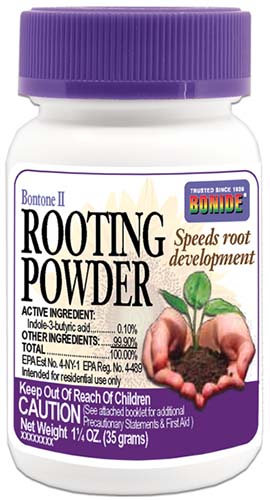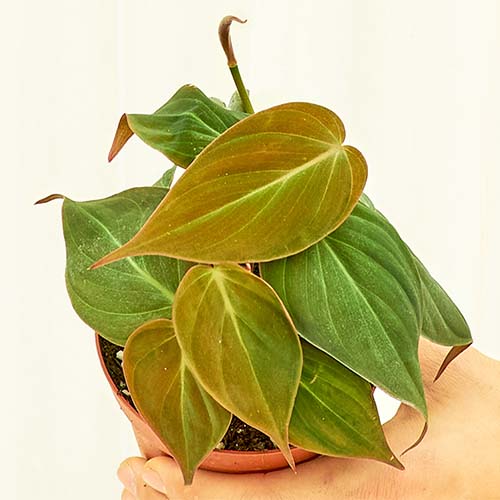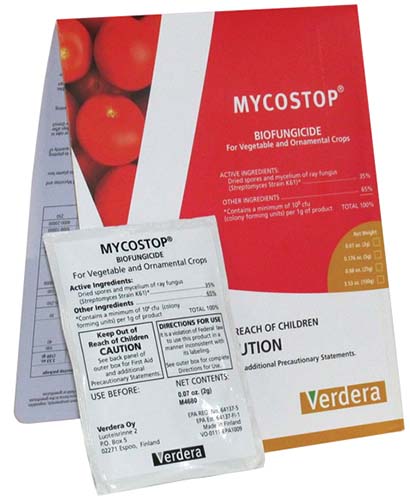Philodendron hederaceum var. hederaceum
I’ve lived with my philodendron micans for many years, and to this day, every time I walk by it, I do a double-take or just gaze at it lovingly.
The heart-shaped leaves are stunning on their own as anyone with a heartleaf philodendron knows, but the bronzey-pink hue really makes micans stand out.
That’s enough to make it extra special, but the leaves also have a velvety texture with an iridescence that sparkles in the light. It’s impossible to ignore.
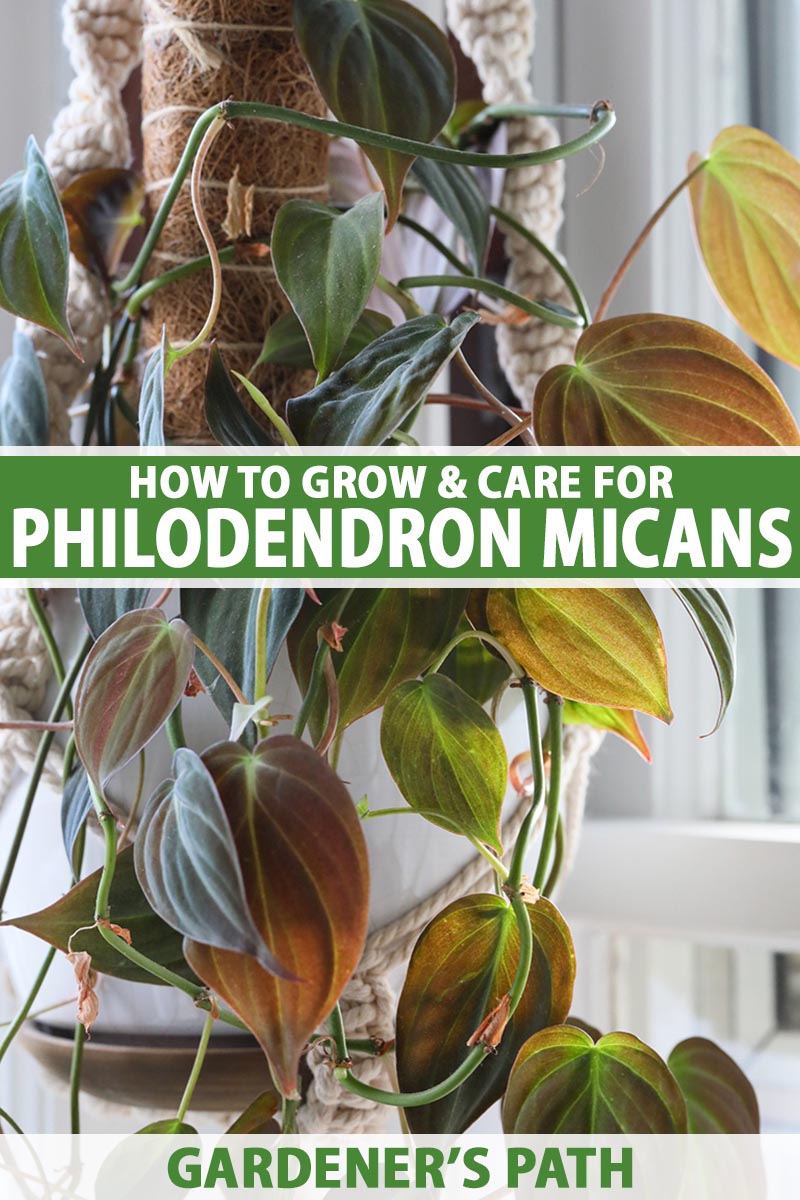
We link to vendors to help you find relevant products. If you buy from one of our links, we may earn a commission.
I’m not the only one who has fallen in love with this vining plant. The Royal Horticultural Society gave philodendron micans its coveted Award of Garden Merit in 1993.
If any plant deserves this honor, in my opinion, it’s this one. I adore it not only because it’s so good looking, but it’s also one of those houseplants that needs hardly any care.
Before jumping in, you might want to check out our philodendron growing guide for an overview of the species in general.
In this guide, we’ll focus on how to keep your micans as happy as can be.
Here’s what I’ll cover:
It helps to know a little bit about where a plant came from to better understand how to care for it, so let’s start with that:
Cultivation and History
Philodendron hederaceum (syn. P. scandens) includes several heart-shaped cultivars and varieties, but it’s specifically the botanical variety hederaceum that is sold under the name “micans.”
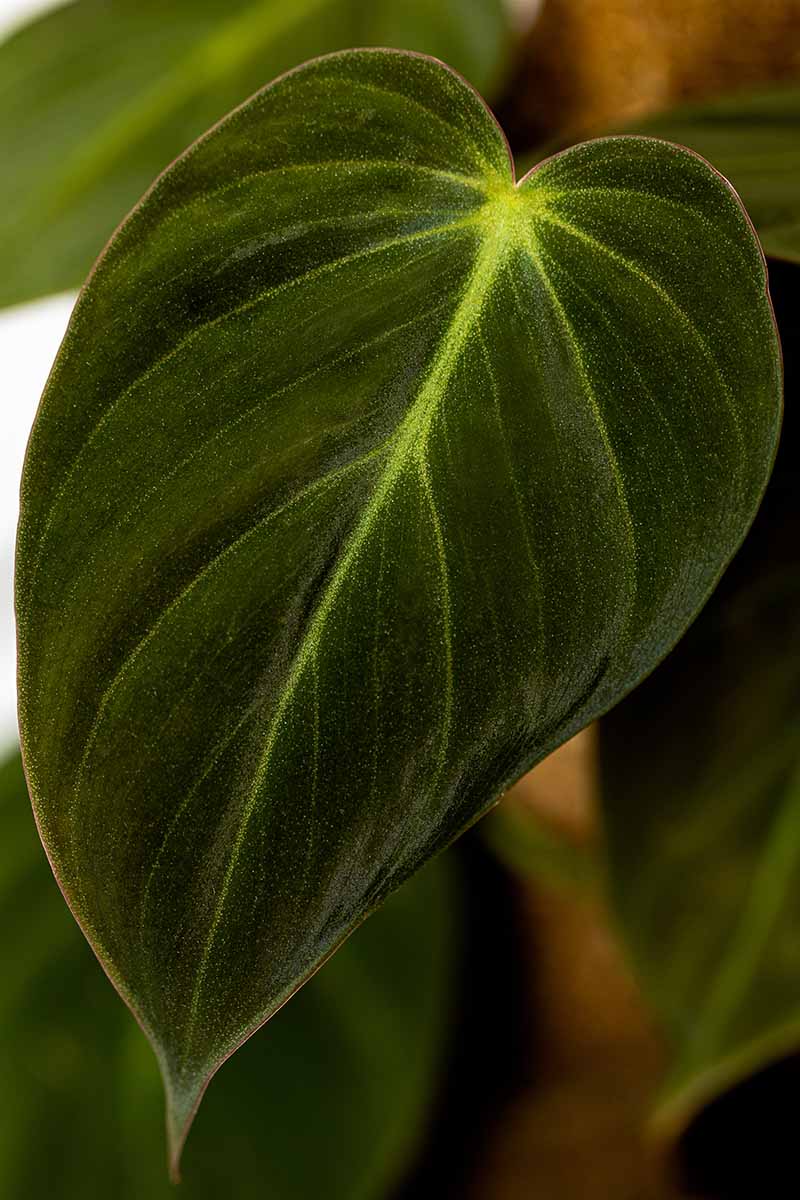
Velvet leaf philodendron, as it is also known, was formerly classified as P. micans, but it’s no longer recognized as a separate species but a naturally-occurring variation of P. hederaceum.
A member of the Araceae family, philodendron micans is part of the group of plants known as aroids.
In their native Central and South America, these plants are secondary epiphytes or hemi-epiphytes that use other trees and shrubs as a support structure to reach light, water, and nutrients.
When the new leaves first emerge from their sheaths, they’re pinkish-red in color. As the leaves age, they turn deep green or greenish-bronze, depending on the light exposure.
Most philodendrons grown as houseplants retain their immature leaves, but if the foliage is able to fully mature, micans leaves can reach up to eight inches across with distinct veins and a true heart shape, known as cordate.
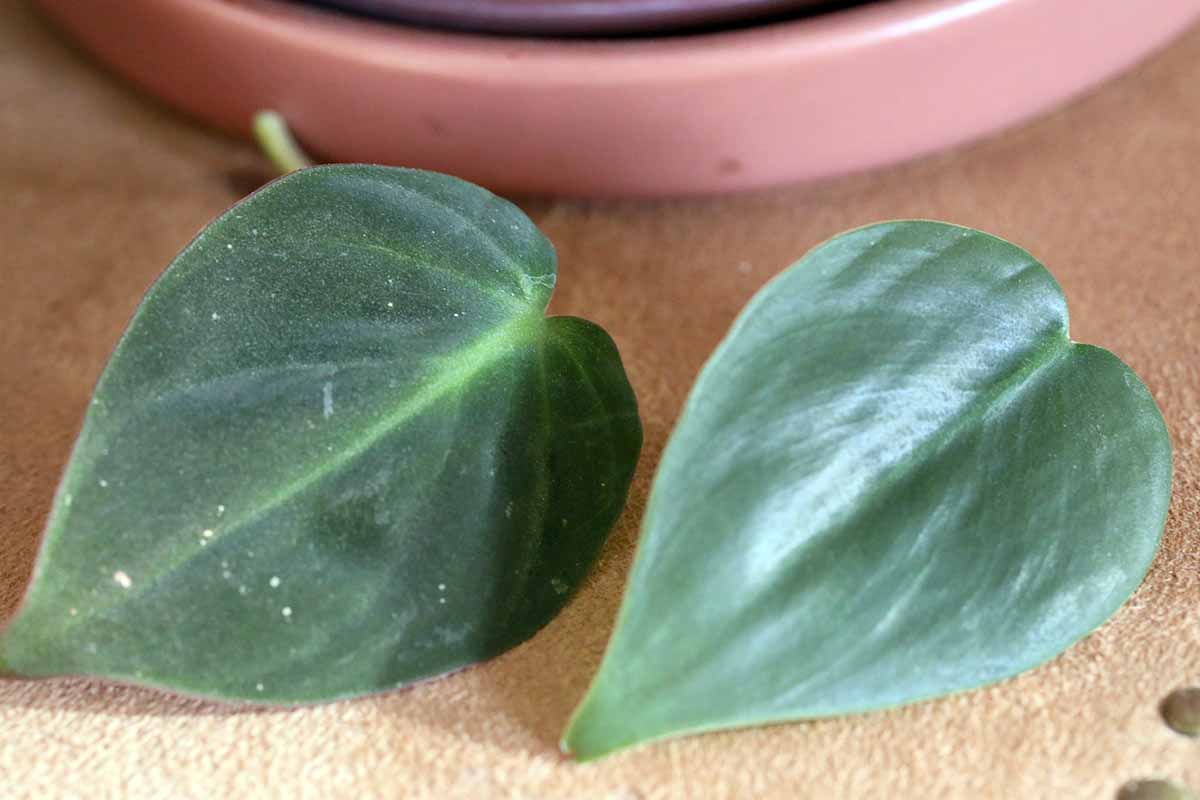
Philodendron micans looks similar in shape to the species, with the big difference being the color of the foliage.
Outdoors, philodendron micans can grow up to 20 feet long and 10 feet wide and will form spathes of white flowers. Indoors, while they can grow just as large if provided with the right light exposure, they rarely bloom.
The plant contains calcium oxalate crystals, which can be irritating to the skin and mucous membranes, so I wouldn’t recommend making a heaping salad of the leaves, but philodendron micans isn’t considered particularly toxic.
Philodendron Micans Propagation
At one point, I had over a dozen philodendron micans specimens hanging out around my house.
As I already mentioned, I adore them, but that’s not why I had so many. I used to have a cute little mini vase rack that I liked to keep full of cuttings as a display in my kitchen.
The philodendron micans cuttings rooted so readily, and I just couldn’t bring myself to toss out the young plants, so I potted them up when they got too big for the display. I ended up giving them away as gifts lest I run out of space!
All that is to say that you can propagate these plants easily. You can choose to buy a plant, divide an existing specimen, or take cuttings.
From Division
To divide a vining philodendron like micans, it must have at least four stems coming out of the soil.
They develop multiple stems pretty rapidly, so a plant that is a few years old is likely to be ready for dividing.
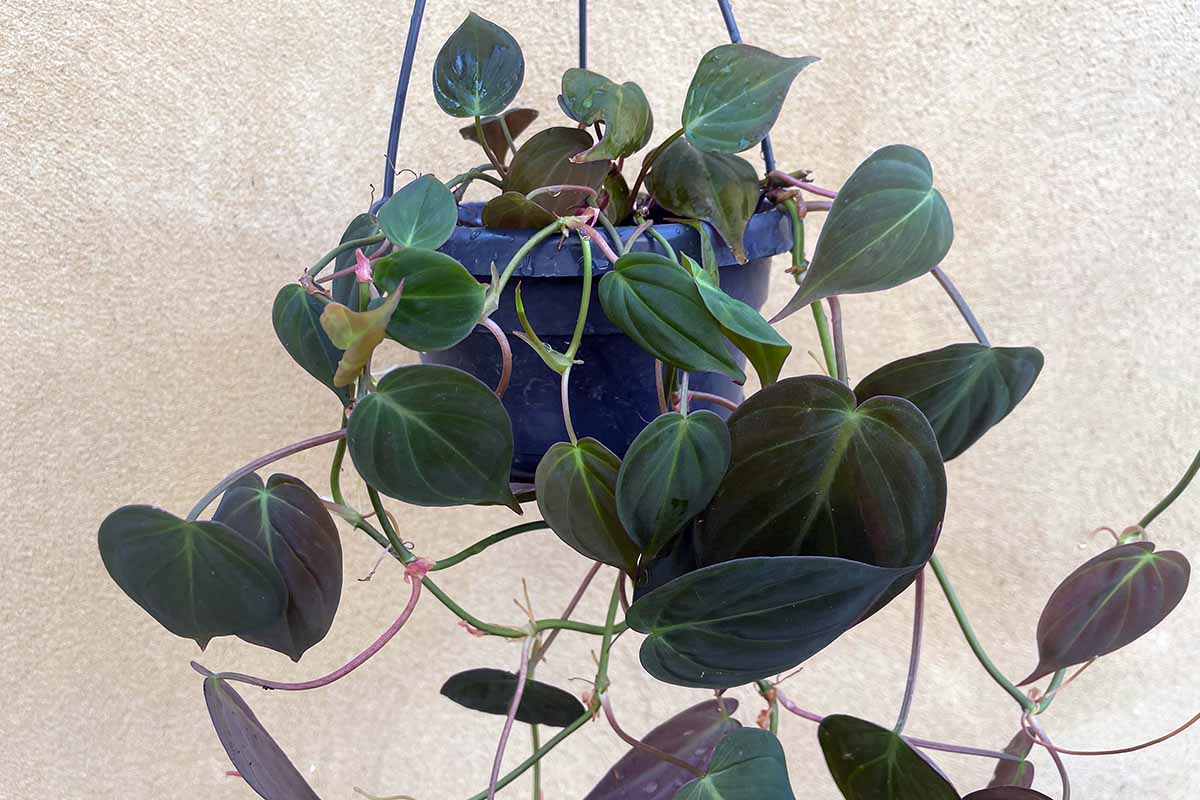
Remove the plant from its container and gently brush away the soil so you can see the roots. Loosen up the roots a bit so you can see where there is some natural separation.
The size of the division doesn’t matter so long as you can obtain two stems and a chunk of root.
Gently tease apart a few stems with roots attached. If the roots are too tangled, you can use a clean pair of scissors to separate them.
Put one section back in the original container and pot up the other section or sections into their own containers. Fill around with fresh new soil and add enough water so that it starts to run out of the drainage hole.
From Cuttings
Ready for one of the easiest propagation jobs out there? Take a healthy piece of stem that is about six inches long and cut it off just below a leaf.
The stem needs at least two leaves on it. It’s not the leaves that are important, but the nodes, as that’s where the roots will emerge.
Pull off all but the top leaf or two so there is at least one bare leaf node and dip the cut end in rooting hormone.
Bonide Bontone II Rooting Powder
You can pick up a 1.25-ounce container at Arbico Organics, and it will last you through a lot of propagation projects.
Fill a four-inch pot with water-retentive, rich potting medium. Moisten the potting medium and then make a small hole in it with your pinky finger, a chopstick, or a pencil.
Stick the stem into the potting medium so that it’s an inch or so deep, and firm the soil up around it. Tent a piece of plastic over the cutting to help retain humidity.
Philodendron micans cuttings will grow best when they are exposed to a bit more light than most houseplant species would typically require.
Provide direct light in the morning and early afternoon, and bright, indirect light for the rest of the day. Alternatively you can use a grow light.
After a few weeks, wiggle your fingers into the soil and under the cutting. Gently lift it up and look for roots.
If you see roots, your cutting is ready to be transplanted into its permanent container. If you don’t see any roots, go ahead and firm it back in the soil and give it more time.
You can also place the cuttings into water rather than soil.
You can use a regular glass but if you prefer to display the cuttings that you’re propagating, have a look at this set of five propagation jars, complete with wooden stand from Mkono, available via Amazon.
Keep the cuttings in bright light and change the water every other day. When the roots are an inch or so long, you can transplant.
Transplanting
If you buy a specimen, you can leave it in the original container for a few months or repot it into a slightly larger container right away if you prefer.
When you’re ready to repot, pick a container one size up from the existing pot. The container should have drainage so that excess water can run out.
Gently remove the plant from its container.
Loosen up the root ball a little and snip away any black or mushy roots.
Fill in around with fresh potting soil, then firm the soil down gently and water. If the soil settles, add a bit more.
How to Grow Philodendron Micans
Philodendron micans requires a good amount of light to develop the bronzy color and velvety iridescent effect on the foliage.
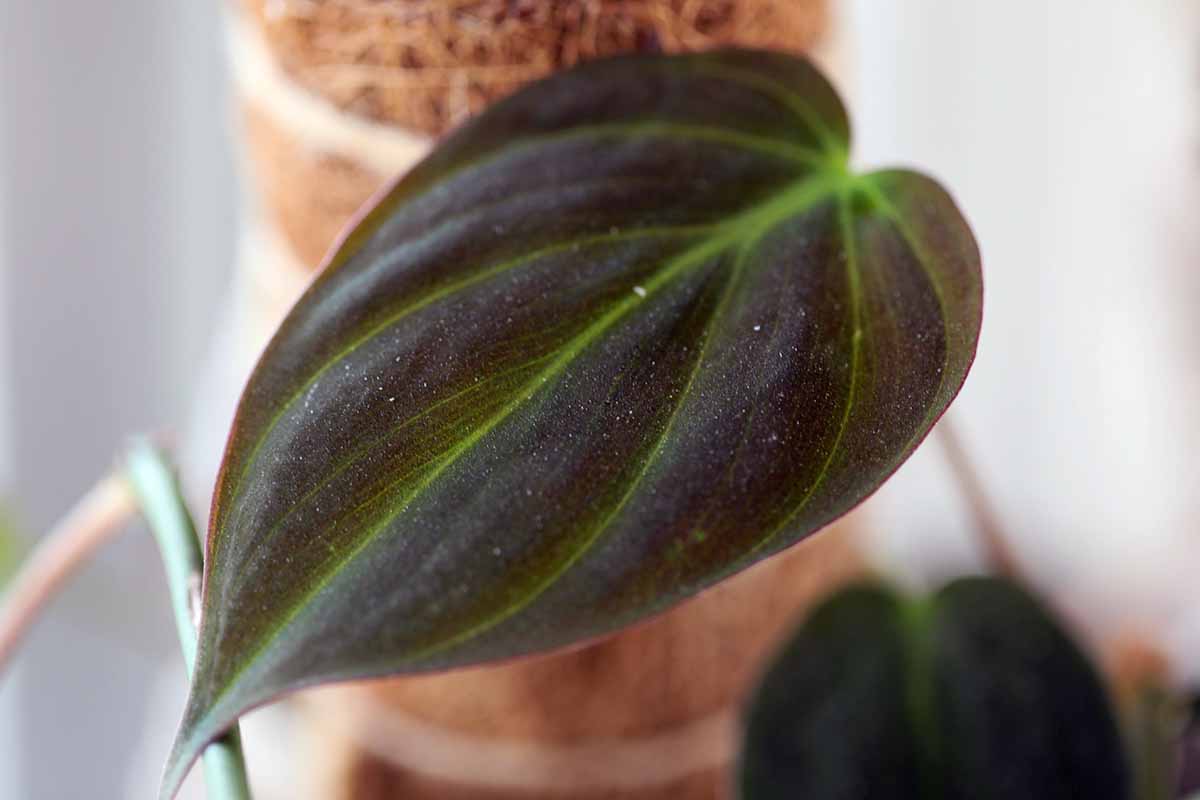
An area with direct morning light but protected from direct afternoon light is ideal, or a spot with bright, indirect light with a southern exposure would work, as well.
You should provide the plant with brighter light to encourage the bronze coloring. If you prefer the green hue, aim for less light.
If the plant starts to grow long and leggy, it’s a sure indication that it isn’t receiving enough light.
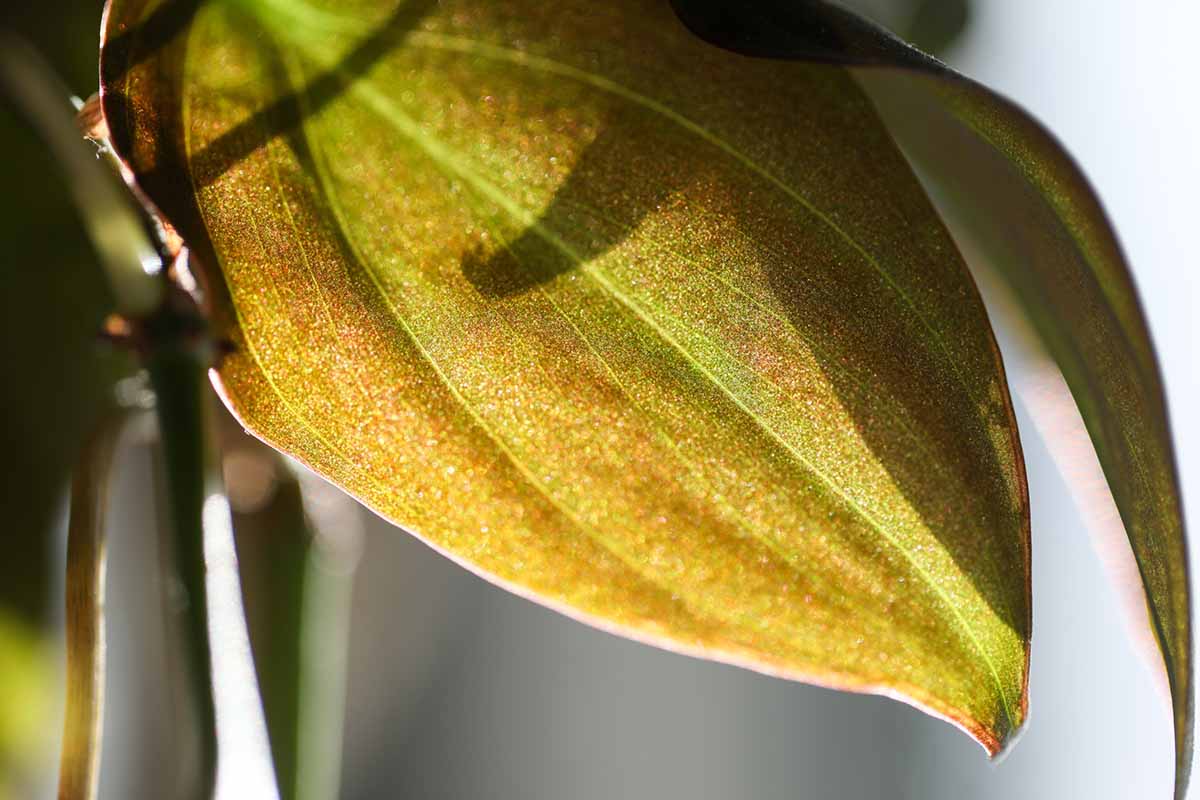
These plants love a moss pole to climb up or you can allow your micans to be entirely trailing. Remember, they usually climb onto another plant in nature.
When it comes to watering, philodendron micans likes the potting medium to remain consistently moist but not soggy and wet.
The best tip I can give you is not to water on a schedule. The amount of water a houseplant needs will vary constantly depending on the light, temperature, ambient humidity, and other environmental factors.
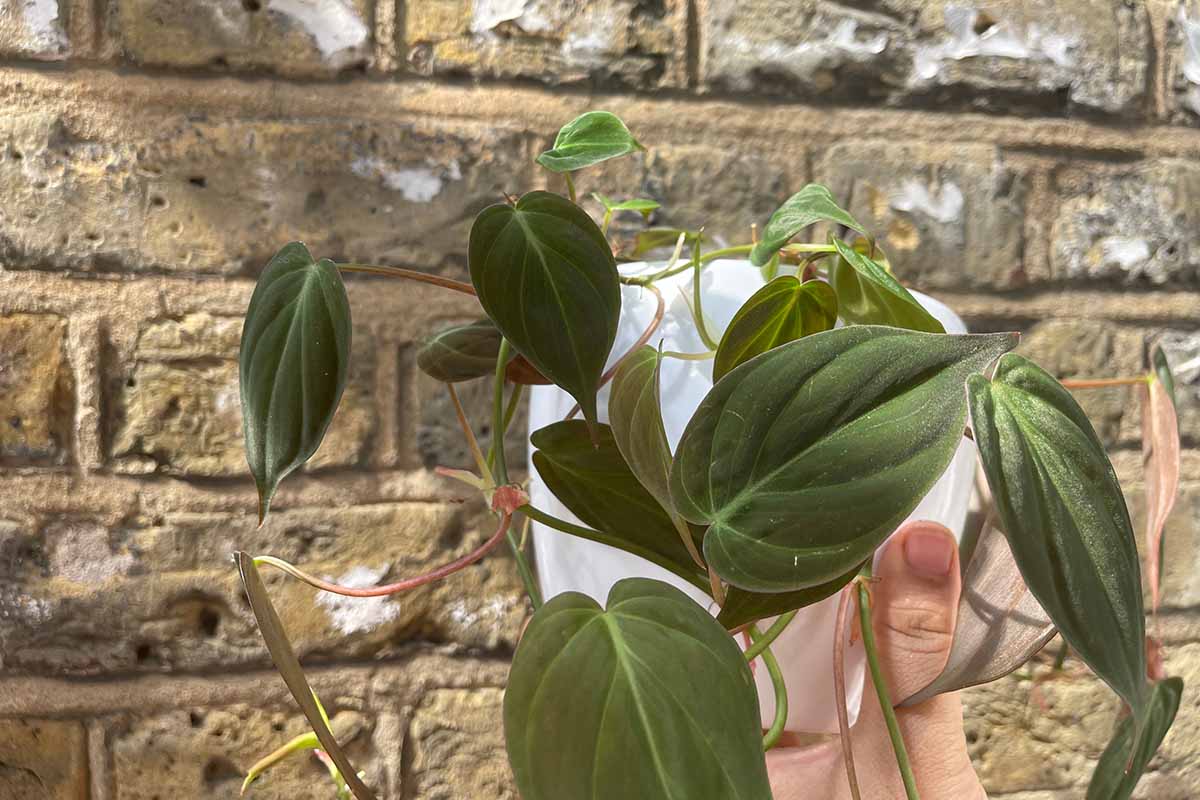
You might water once a week during the summer and once every other week during the winter.
It’s better to check the soil every time before you water. You might eventually be able to tell just by lifting the pot and testing the weight, but until then, just stick a finger into the soil.
It should be dry about a quarter to halfway down into the pot. If you don’t want to dirty your finger, you can always use a soil moisture meter instead.
When you water, make sure to do so at the soil level and keep going until the liquid runs out of the drainage hole. If you have a catchment container, empty it after about half an hour.
Speaking of soil, choose something loose and rich, with water-retentive properties. Moss, perlite, and vermiculite are both common water-retentive ingredients.
My favorite soil for houseplants is FoxFarm Ocean Forest.
It contains earthworm castings, bat guano, fish meal, humus, sandy loam, and sphagnum moss combined to create a medium that all my plants seem to love.
It’s available in one and a half cubic foot bags via Amazon.
Don’t expose your plant to temperatures below 55°F or above 90°F. Ideally, you want to situate it in an area that stays between 65 to 80°F.
If you see dark brown blotches between the leaf veins, this indicates the plant was exposed to temperatures that are too low.
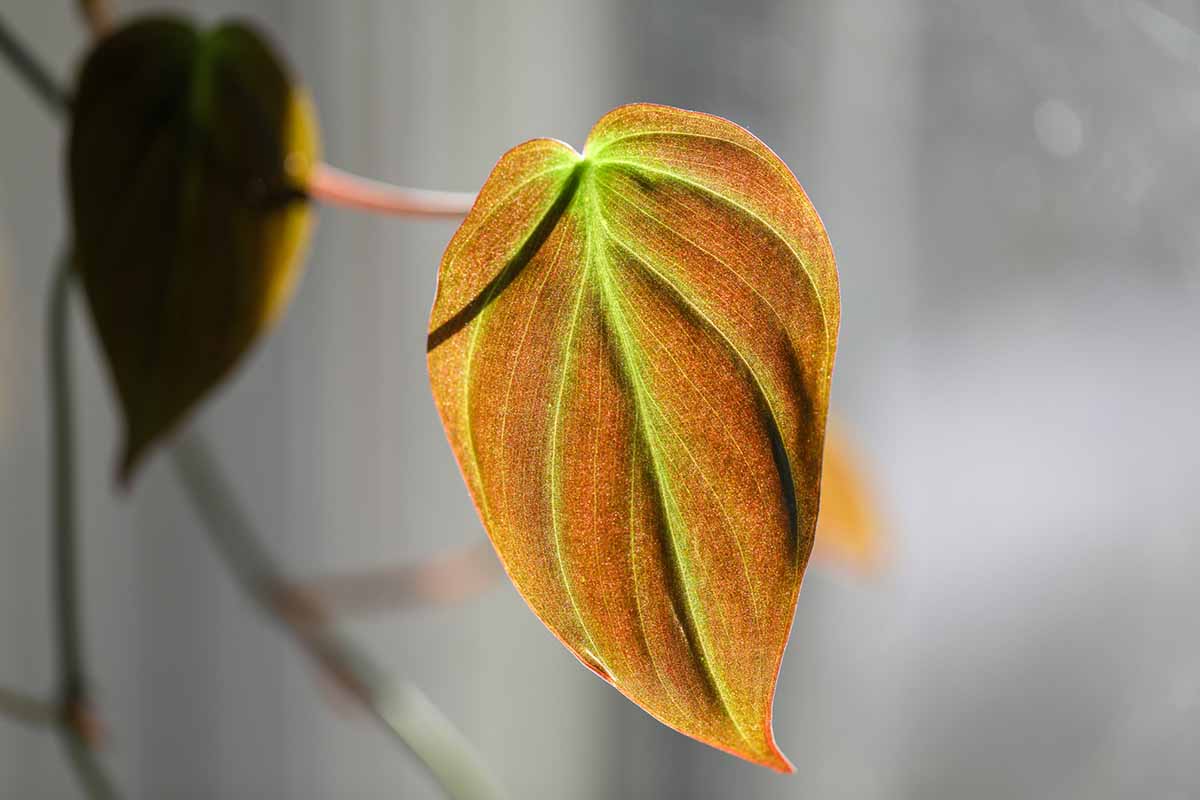
This can happen during the winter if your plant is situated near a window or exterior door.
Philodendron micans will adapt to just about any humidity level, though it may develop brown leaf tips in very dry areas. Aim for humidity between 40 to 60 percent.
Feed your plants once a month from spring until fall, but hold off during the winter. Use a balanced, mild fertilizer. It’s usually easiest to look for one formulated for houseplants.
Dr. Earth’s Pump and Grow for houseplants is easy to use thanks to its pump. It also has a perfectly balanced and mild NPK ratio of 1-1-1.
You can grab a 16-ounce container at Arbico Organics.
Overfeeding will result in the leaves curling at the end. Underfeeding can cause v-shaped yellow areas to form on the leaves, which indicates magnesium deficiency.
Growing Tips
- Keep your plants in bright, indirect light or some direct morning exposure.
- Water when the top quarter of the soil has dried out.
- Feed once a month, spring through fall, with a mild, balanced food.
Pruning and Maintenance
You don’t have to prune philodendrons, but you can always cut them back to encourage bushier growth or to remove straggly vines.
Plants grown in too little light tend to become leggy, with long internodes, which is the area between the leaves.

You should always prune off any dying, diseased, deformed, or discolored leaves or stems as you notice them.
When you decide to prune, visit our guide to learn everything you need to know about the process.
Every few years, you’ll likely need to either divide or repot the plant into a larger container. Don’t go too large, though. Philodendrons, as with most aroids, like to have their roots a bit snug.
Unlike self-heading or non-climbing species, climbing philodendrons like micans don’t necessarily need to be divided, but it’s an option if you want to multiply your plants or you don’t want to increase the pot size.
Where to Buy Philodendron Micans
A few years ago, it was hard to find philodendron micans at stores. Now, you can find them all over the place.
You can find a cute little plant in a four-inch pot available via Walmart.
If you prefer something a bit bigger, you can grab a more established plant in an eight-inch pot from California Tropicals via Amazon.
By the way, in your search, you’ll probably come across philodendron micans plants with pink foliage. They’re absolutely stunning but I would advise you not to buy one.
The pink coloring comes from the hormone ethylene, which growers give to the plant to induce the hue artificially.
Once new leaves form, they’ll emerge in their normal color, and the existing pink leaves will revert back to green over time.
Managing Pests and Disease
So long as you support your plants with the right care, it’s unlikely that you’ll ever experience problems.
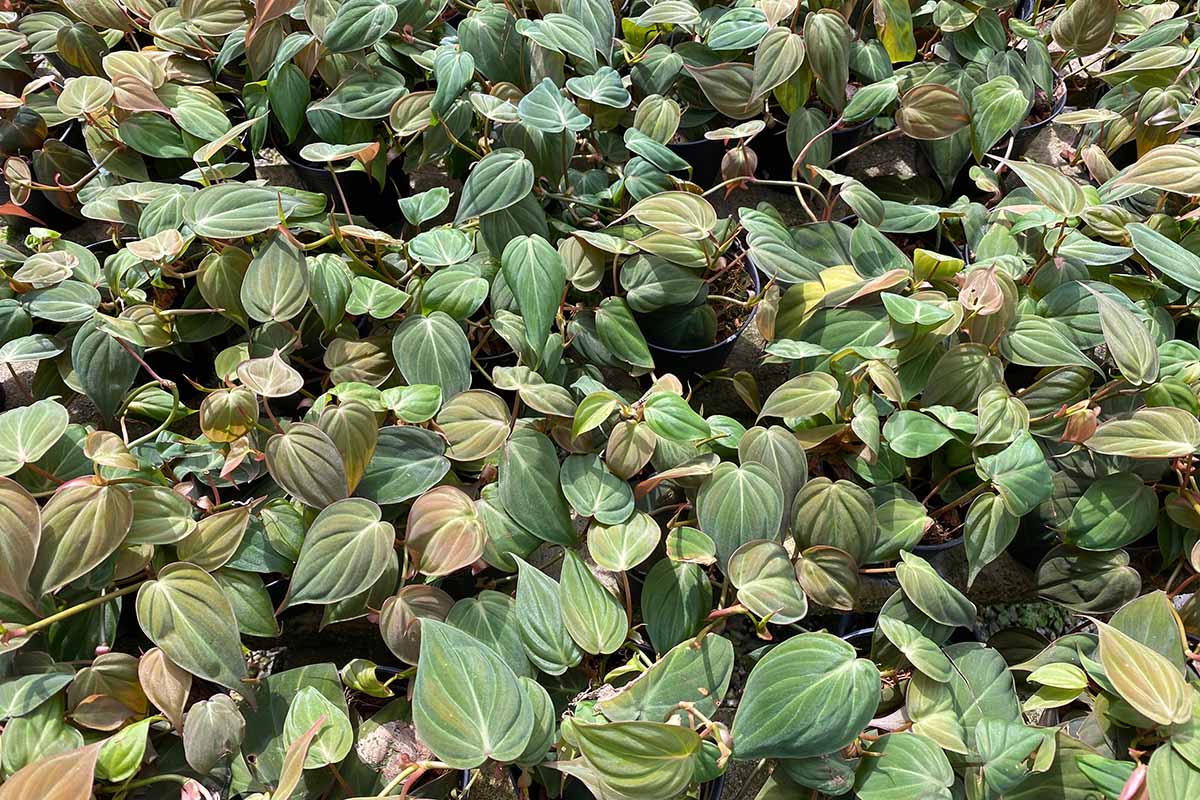
Pests are more common than diseases, but they are more likely to attack other houseplant species before they’re going to go for your philodendron micans.
Perhaps there’s something about those velvety leaves that doesn’t appeal to bugs!
Insects
All the usual houseplant suspects can affect micans, but if you catch an infestation early, it’s rarely a problem.
Let’s start with public enemy number one:
Aphids
Aphids are an extremely common household pest. They will feed on philodendron micans, especially if the plant is already stressed.
These tiny pests use their sucking mouthparts to draw out the sap from plant tissue. This will cause the leaves to turn yellow or have yellow speckles.
You’ll also often see a sticky, clear substance on the stems and foliage. This is the honeydew that the aphids secrete as they feed.
It’s fairly easy to treat aphids if you catch them early. You can usually spray them off with a strong stream of water or use a broad-spectrum insecticide.
We have lots of tips in our guide to dealing with aphids, so be sure to read it if you want more details.
Mealybugs
Mealybugs are closely related to scale, which we’ll talk about next, and the treatment is similar.
These small oval insects sap the suck out of the plants, moving so slowly that you might not even realize they’re alive. As they drain the plant, the leaves turn yellow and new shoots might die.
These pests are covered in a waxy white or gray substance, which make them kind of look like the symptoms of a fungal infection. Like aphids, they secrete a sticky substance called honeydew.
You can wipe each individual insect with a cotton swab dipped in isopropyl alcohol. You can also add an insecticide for a double-whammy.
For more details, read our guide to dealing with mealybugs.
Scale
Similar to mealybugs, scale are flat, oval insects but they lack the waxy coating. At first glass, an infestation might look like some sort of lumpy leaf spot disease.
They cause the same damage and can be controlled the same way as mealybugs. We also have a guide that explains how to address a scale infestation.
Disease
Diseases are rare and usually associated with overwatering, overcrowding, or poorly draining soil.
Bacterial Blight
Bacterial blight is caused by Erwinia carotovora pv. carotovora. When it infects your plant, you will see small dark green spots that are almost black on the foliage and stems.
As they expand, the entire leaf and petiole will turn into mush. If you take a whiff, the plant will smell like the water in a flower arrangement if you leave it unchanged for a week or two.
The bacteria spread in water, so good air circulation and avoiding water splash is important.
Once your plant is infected, there’s no cure, so it’s best to toss the specimen rather than risk the disease spreading.
Bacterial Spot
Bacterial spot is a disease caused by the pathogen Zanthomonas campestris pv. dieffenbachiae.
Look for tiny spots on the margins of the leaves. They’ll usually look water-soaked, but as they age, they take on a tan or reddish-brown hue and might have yellow halos.
Most often, plants are infected at the nursery or greenhouse, and the symptoms don’t show up until much later.
You should always check any plants you purchase for signs of disease, but symptoms won’t necessarily be obvious.
Once again, there’s no cure, so you’ll need to dispose of the infected specimen so the disease doesn’t spread.
Root Rot
There are two causes of root rot. The first is chronic overwatering which results in the roots sitting in oversaturated soil unable to access sufficient oxygen.
The other cause is infection from oomycetes in the Pythium genus, which need lots of moisture to thrive.
In both cases, the result is yellowing leaves that will eventually turn brown. The leaves typically won’t drop from the plant. If you look at the roots, they will be black and mushy.
Root rot is one of the most common problems in houseplants.
I’ve found the best treatment is to remove the plant from the soil, wash out the pot with soap and water, and repot the plant with fresh potting soil.
Then, soak the soil once a month with Mycostop, a biofungicide that uses the beneficial bacteria Streptomyces strain K61 to kill pathogens like oomycetes.
Purchase five or 25 grams at Arbico Organics.
You can learn more about how to deal with root rot in our guide.
Best Uses for Philodendron Micans
If you live in Zones 10 to 12, this plant is a beautiful ground cover or trailing option for the garden.
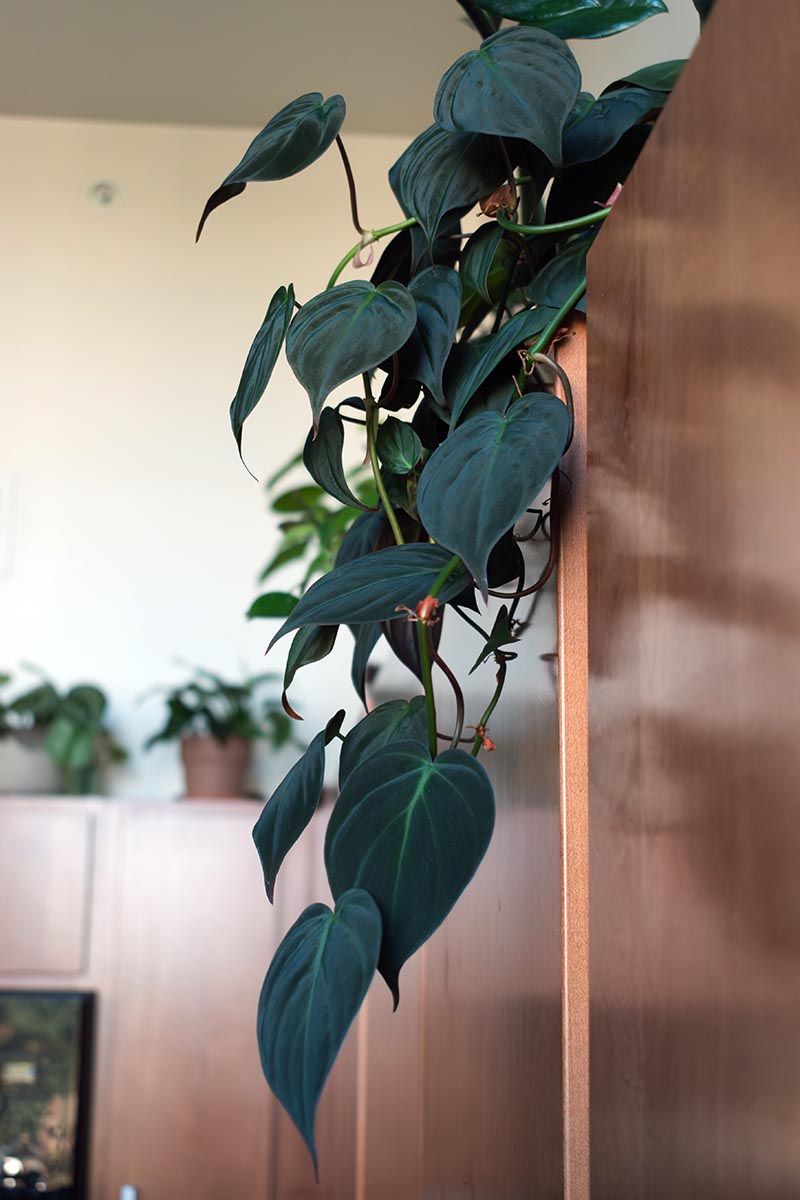
As a houseplant, it’s lovely climbing up a pole or wall – with support of course. Put it in a hanging pot or display it trailing down a bookshelf.
Quick Reference Growing Guide
| Plant Type: | Herbaceous aroid epiphyte or hemi-epiphyte | Foliage Color: | Bronze, pink, green |
| Native to: | Central and South America | Tolerance: | Some low light |
| Hardiness (USDA Zone): | 10-12 | Soil Type: | Loose, airy, humus-rich |
| Exposure: | Bright, indirect light, morning direct light | Soil pH: | 6.0-7.5 |
| Time to Maturity: | 8 years | Soil Drainage: | Well-draining |
| Length: | 20 feet | Uses: | Hanging plants, climber, ground cover (outdoors) |
| Spread: | 10 feet | Order: | Alismatales |
| Growth Rate: | Fast | Family: | Araceae |
| Water Needs: | Moderate | Genus: | Philodendron |
| Maintenance: | Low | Species: | Hederaceum |
| Common Pests and Diseases: | Aphids, mealybugs, scale, spider mites; bacterial leaf spot, root rot | Variety: | Hederaceum |
All Hail The Mighty Micans
I could go on raving about how much I love philodendron micans, but I’m hoping that you’re already a convert after reading this guide. It’s truly a beautiful yet carefree houseplant option.
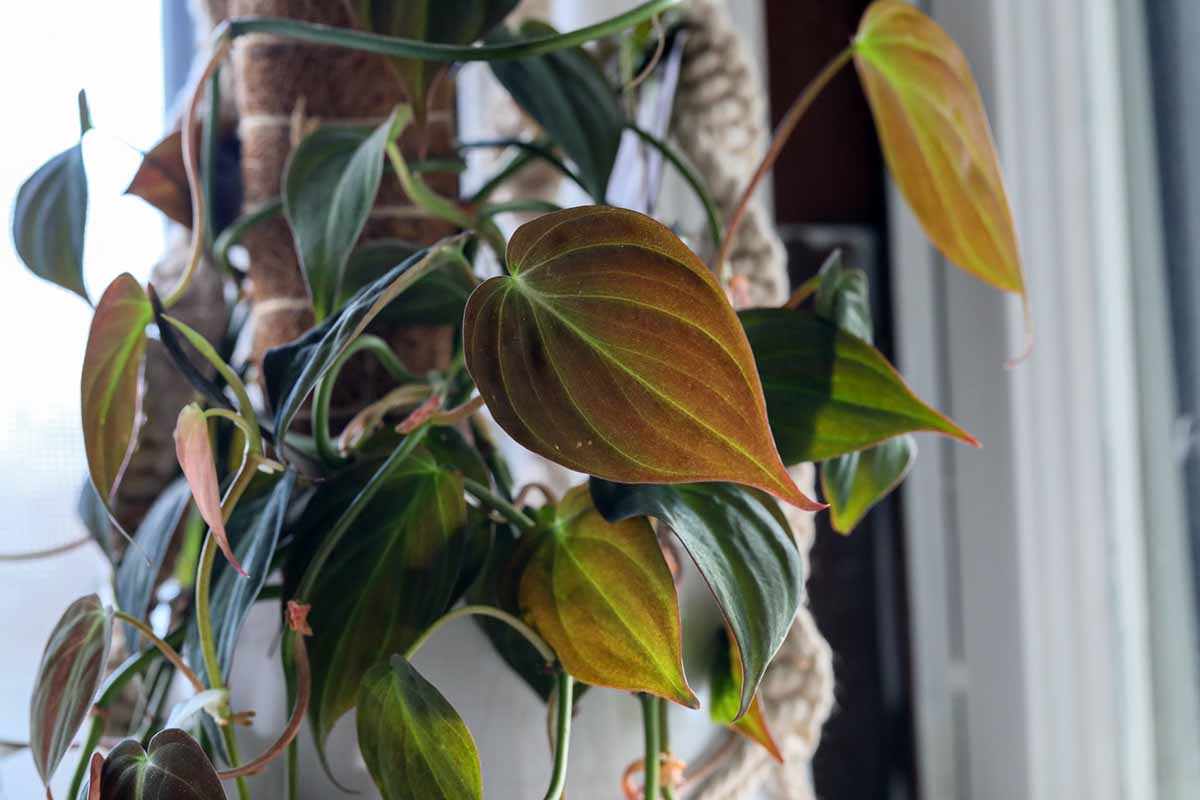
How are you growing your philodendron micans? Is it climbing up a moss pole or trailing over the sides of a hanging container? Let us know in the comments section below!
And for more information about growing philodendrons, check out these guides next:

